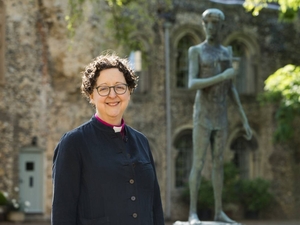Countryside walks
THERE are some amazing walks around our diocese – and some incredible churches that you can visit. Plan carefully and you could do both at the same time!
The landscape of south-east Hampshire is typical English countryside, with the rolling South Downs, green farmland and picture-perfect villages. Then there are the beaches across the south coast, with an ever-changing view of ferries, yachts and boats on the horizon. And each harbour has its own distinct character, with marine and birdlife prominent.
And the Isle of Wight has so much to offer holiday-makers, ramblers and cyclists that it sustains an entire tourist industry. There are miles of sandy beaches, plus historic villages, vertical cliffs and verdant chines. When combined with a mild micro-climate, it’s a great place to get out in the fresh air.
And many of our historic church buildings remain open during the day, so that walkers and hikers can pop in. Whether it’s shelter from heavy rain or blazing sunshine, or just a good place to eat a packed lunch, our churches are fascinating places to have a break.
We’ve put together a few of our favourite church walks in the diocese, but there are many more:
1. Tennyson Down, Isle of Wight
One of the most exciting places to be is right at the western tip of the Isle of Wight, taking in a view of the three near-vertical stacks of chalk called the Needles (see photo above). You can reach them via an exhilarating tramp across Tennyson Down, which is part of the chalk downland that forms the backbone of the island – or you can take a breath-taking trip in a chairlift down to the multi-coloured sands of Alum Bay and visit them by boat.
Either way, your visit might also include seeing the only church with a thatched roof on the island – St Agnes in Freshwater Bay. The Victorian poet Alfred, Lord Tennyson lived at nearby Farringford, and it was his son Hallam who donated land for this new church in 1908. The church nestles beneath Tennyson Down, named after the poet, and it’s on a cycle route around the Isle of Wight.
2. Sandown Bay and Shanklin Chine
Similarly exhilarating is the walk along the entire stretch of Sandown Bay on the eastern side of the island. It’s part of the Isle of Wight Coastal Walk, and you can take in all five miles of its sandy beach, or walk along the sandstone cliff-top. You can visit the seaside resorts of Sandown and Shanklin, perhaps visiting St Saviour-on-the-Cliff Church as you head towards Shanklin Chine or the picturesque heart of the old village.
Shanklin Chine is a wooded coastal ravine, which includes a stream running through it and a number of waterfalls. Originally popular in the Victorian era, it’s now open day and night – with the stunning lighting a particular interest.
Emerge at the other end, and it’s only a short walk to St Blasius Church, Shanklin. It’s a historic church which may have been originally built in the 12th century, but much of what remains dates from a restoration in 1852.
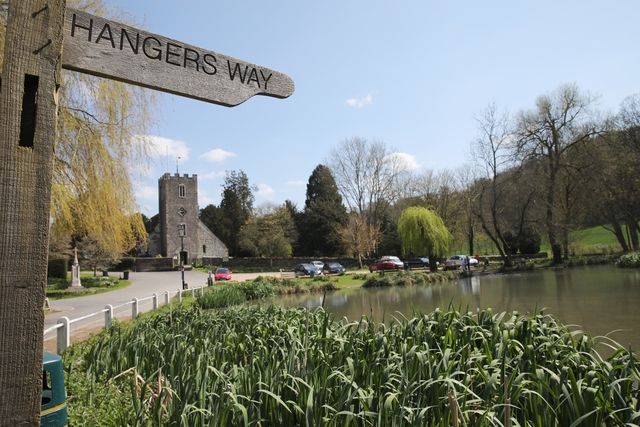
3. Queen Elizabeth Country Park and Buriton
Fancy a forest walk that takes in this idyllic village scene of historic church and quiet duckpond? You can include St Mary’s Church, Buriton, in a walk from the Queen Elizabeth Country Park.
The vast country park is ideal for ramblers and cyclists, and has several pitches where groups can host barbecues. But it doesn’t take too long to get away from the crowds and enjoy the seclusion of the forest itself.
Why not park in the car park for the Queen Elizabeth Country Park, and head south, passing the café and a children’s play area. A tarmac path will swing you to the east – an alternative is to take a parallel footpath just to the south of the tarmacked road. Follow the South Downs Way, which takes you off the tarmacked road and onto a bridleway, heading slightly upwards.
After a path joins you from the right, you’ll face a fork in the path. Continue along the South Downs Way, then take a right fork, which takes you out of the forest and swings you round into Halls Hill car park. Near the intersection with Kilns Lane, you take a dirt track through a small wooded area that is full of quarry holes.
Go under a railway bridge and you’ll emerge next to the pond in Buriton. It’s a great place to eat lunch, as you watch the ducks. There are also some excellent pubs nearby.
Beyond the pond is the historic St Mary’s church. The original building there dates from 1086, but this church was built in Norman times and until 1886 was the mother church for the whole of the Petersfield area. Take a few moments to appreciate its 12th century nave and 18th century tower.
You can retrace your steps, or you can complete a circular walk. Walk past the Five Bells pub and turn left at the Nest Hotel up Kiln Lane. Turn right just after the railway bridge, back into the forest. You’ll soon hit the signposted routes inside the Queen Elizabeth Country park and be able to make your way back to its café - there are a few routes to choose from.

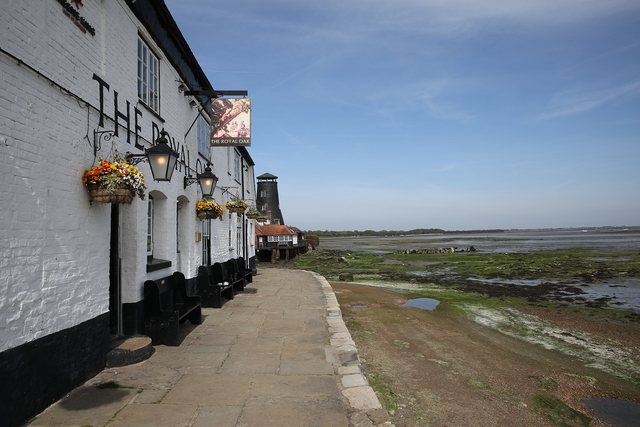
4. Langstone to Emsworth
Walk along this part of the coastline and you’ll have a close-up view of the flora and fauna of Chichester Harbour. There are fascinating glimpses of marine life, bird-filled skies and colourful seaweeds as you traipse across the coastal path. However, you may want to check tide times, or else you may get trapped by the sea and have to wade through ankle-deep water.
You can start in Langstone High Street, next to the tiny St Nicholas Church, which is now holding regular worship services again. Pop inside to discover more about the rich history of Langstone. Walk past the Royal Oak (or pop in for pint!) and the historic tower mill, and your first stop might be to admire the birdlife in the mill pond.
Stick close to the water’s edge all the way to Emsworth. Keep your eyes peeled for curlews, godwits, redshanks and dunlins – and maybe even seals, if you’re lucky. You’ll walk past some Emsworth homes with beachfront gardens, and then you’ll reach the Emsworth Millpond.
The town has a rich history for fishing, sailing and boat-building, and the tidal millpond was created in the 18th century to serve its mills. You can walk all the way around the millpond, or to pause in one of the town’s many cafes.
You can choose to return to Langstone the same way, or to branch off onto the Solent Way. This takes you across fields and ultimately past Warblington Castle, St Thomas a Becket Church, Warblington, and the churchyard and cemetery.
Over the summer weekends, the church is often open for afternoon teas, which is a great excuse to kick off your hiking boots and relax.Cross a field on the other side of the cemetery and you’ll return to the coastal path, and then back to Langstone.
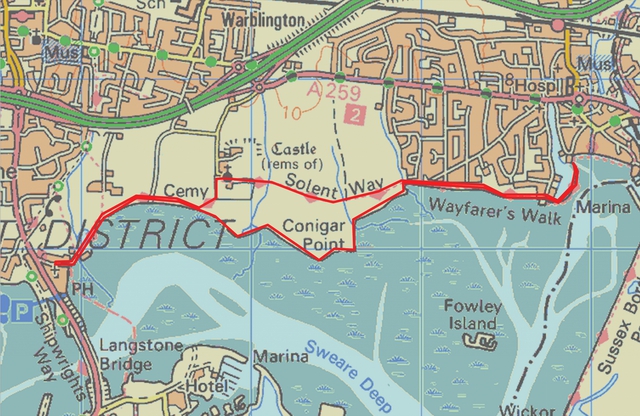
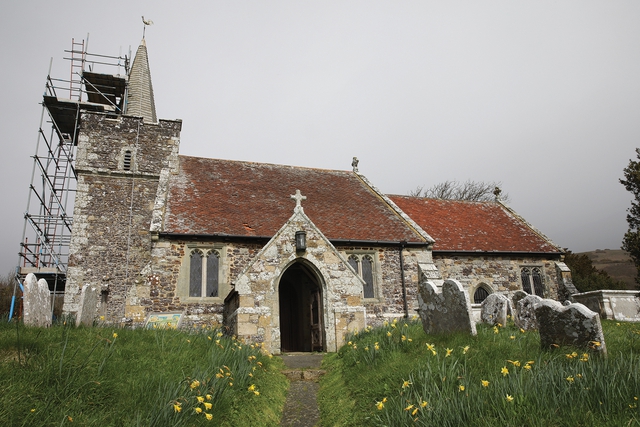
5. The Warrior Trail, Isle of Wight
He was dubbed ‘the horse the Germans could not kill’ - and you can follow in his footsteps! The Warrior Trail is a six-mile circular trail on the Isle of Wight that was created to recall an infamous First World War story. Warrior was the real-life war horse of General Jack Seely, who survived some of the war’s most famous battles.
The general was a friend of Winston Churchill and his horse was raised and trained on the island. When Warrior returned in 1918, he became a local hero – he went on to win the lightweight race at the Isle of Wight Point to Point in 1922.
The Warrior Trail follows much of the route on which Warrior was exercised, including the beach at Brook Bay where he was trained to deal with fighting in the surf. It includes the villages of Brook and Mottistone and their historic churches.
Begin near Five Barrows, an ancient burial mound, past which Warrior might have galloped. Wind through the picturesque village of Brook to the old lifeboat station on the coast, near where Warrior would have trained.
The exhilarating coastal path gives you the chance to gaze out into the English Channel as you stroll east. Turn left and head into Mottistone via Ridget Lane, and you can pause for a moment in Mottistone Church.
Originally built in medieval times, the current building dates from the 15th century. Its parclose screen was designed by Lord Mottistone in memory of his father – the General Seely who rode Warrior. Head through the grounds of Mottistone Manor – the home of General Seely and Warrior until the 1940s – towards the Longstone, a neolithic ceremonial worshipping stone. If it’s the right time of year, the scent of bluebells will hang in the air in the hollow-way.
Then there’s a heady walk under Mottistone Down towards Brook Hill House and Brook Church. Behind the church is a field where Warrior spent his younger days.

6. Meon Valley trail, Droxford
On the mainland, it’s hard to find a church more conveniently situated for walkers, hikers and cyclists than St Mary and All Saints Church, Droxford. It is near both the South Downs Way and the Meon Valley trail, so it’s no surprise that worshippers have now created Wilfrid’s Café, which offers hot drinks, home-made soup and home-baked cakes. Everyone, from lycra-clad cyclists to tired walkers with muddy dogs, is welcome to sit inside or outside the church.
7. Titchfield Haven Nature Reserve
The Meon Valley Trail takes you from West Meon in the north, through Warnford, Meonstoke, and Soberton to Wickham, following the River Meon. So there are many other churches it passes close to. Closer to the sea, it runs past St Peter’s Church, Titchfield, forming the boundary of the churchyard for this historic building.
Going back 1,300 years, St Peter’s is thought to be the oldest church in Hampshire where worship has taken place continuously. St Wilfrid himself may have started regular worship there in the 8th century. It’s also a great place to begin a walk through Titchfield Haven Nature Reserve towards Hill Head beach. This area is a renowned wetland area, teaming with life, so it’s worth bringing binoculars.
8. Hayling seafront
If it’s a sandy beach you’re after, you might try the south-western tip of Hayling Island, a favourite spot for kite surfers near to the entrance to Langstone Harbour. It’s quieter than Southsea, but – with just one main road in and out of Hayling Island – traffic can be a problem on sunny days or Bank Holidays.
You could start at St Andrew’s Church, Hayling Island, and head for the beach nearby. Turn right to head for the wind surfers, or turn left and eventually you’ll round a headland and maybe see the RNLI team in action at the entrance to Chichester Harbour.
One opportunity to combine a love of walking or cycling and visiting churches is the annual Ride and Stride event run by Hampshire and the Islands Historic Churches Trust. Participants are sponsored to visit as many churches as possible in one day, to raise money to repair and restore historic churches. This year, it will happen on September 9, so this is a good time to plan your route and find some sponsors. Find out more on www.hihct.org.uk.
Digital maps from Dotted Eyes. Reproduced by permission of Ordnance Survey on behalf of HMSO.
© Crown copyright and database right 2023. All rights reserved Ordnance Survey Licence number 100019919



